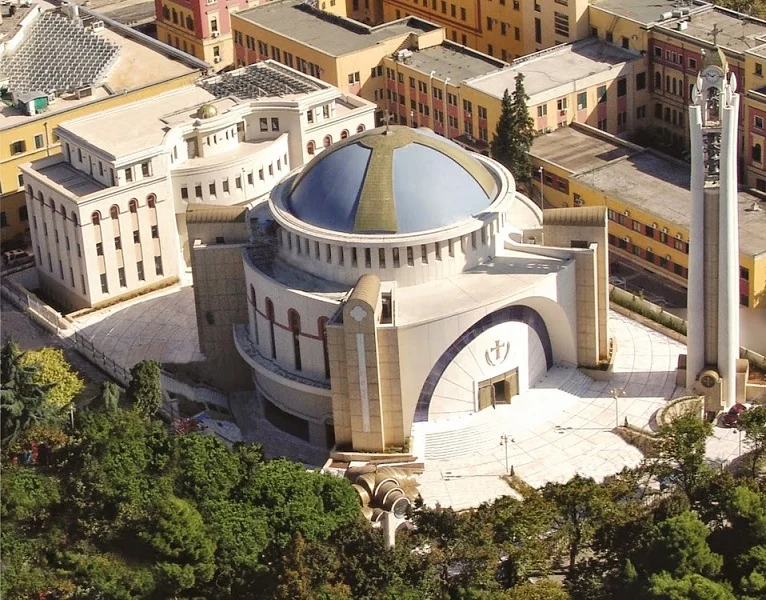
Key Takeaways
- The Resurrection of Christ Orthodox Cathedral is a monumental symbol of Albania’s religious revival and cultural renewal.
- The cathedral’s construction marks the rebirth of Orthodox Christianity after decades of communist repression.
- Its architectural style blends traditional Byzantine influences with contemporary building techniques, creating a timeless yet modern structure.
- The cathedral serves as a central place of worship and major cultural hub, hosting important religious celebrations and national events.
- Located in Tirana’s city center, it is easily accessible for both locals and visitors seeking to explore Albania’s spiritual heritage.
Table of contents
- Resurrection of Christ Orthodox Cathedral: A Symbol of Religious Freedom in Albania
- Historical Background of the Resurrection of Christ Orthodox Cathedral
- Founding and Development
- Challenges and Resilience
- Architectural Features and Design of the Cathedral
- Design Aesthetics
- Key Features
- The Central Dome
- Frescoes and Mosaics
- Iconostasis
- The Bell Tower
- Religious and Cultural Significance
- Center of Worship
- Major Events
- National Identity
- Location and Accessibility
- Current Status and Preservation Efforts
- Conclusion
The Resurrection of Christ Orthodox Cathedral stands majestically in the heart of Tirana, Albania. This monumental structure is not merely an architectural feat but a profound symbol of the nation’s journey towards religious freedom and cultural revival.
Historical Background of the Resurrection of Christ Orthodox Cathedral
Founding and Development
The founding of the Resurrection of Christ Orthodox Cathedral marks a new chapter in Albania’s spiritual history. Initiated in the early 2000s, construction began in 2004 and was completed in 2012, symbolizing a pivotal milestone in the post-communist era. After decades of suppression under the communist regime, its realization stands as a testament to the resilience and determination of the Albanian Orthodox community.
Built on the site of a former communist-era theater, the cathedral embodies a transformation—from oppression to renewed faith and hope. Its development was more than just brick-and-mortar; it was about rebirth for the Orthodox Church in Albania ([Albanian Orthodox Church History](https://www.orthodoxalbania.org)).
Challenges and Resilience
The Orthodox Church endured tremendous challenges during Albania’s communist rule, when the regime declared the country an atheist state in 1967. Religious buildings were destroyed or repurposed, and clergy members faced persecution. Surviving such adversity required unwavering resilience.
Following the fall of communism in 1991, led by Archbishop Anastasios, the church began a process of rebirth. The new cathedral stands as a symbol of this revival, replacing old structures and embodying renewed faith and hope.
Architectural Features and Design of the Cathedral
Design Aesthetics
The cathedral’s design is a harmonious blend of traditional Byzantine influences with modern architectural techniques. Its domes, arches, and cross-shaped layout evoke Orthodox ecclesiastical heritage, while contemporary materials and construction methods give it a fresh, relevant appearance.
Key Features
The Central Dome
The prominent central dome symbolizes Christ Pantocrator, emphasizing divine omnipresence. This massive dome allows a flood of natural light, creating an uplifting atmosphere inside.
Frescoes and Mosaics
Adorning the interior walls are intricate frescoes and mosaics illustrating biblical stories, saints, and religious scenes. Crafted with traditional techniques, these artworks enrich the spiritual and aesthetic ambiance of the cathedral, connecting worshippers with centuries of Orthodox tradition.
Iconostasis
The iconostasis is a beautifully decorated screen separating the nave from the sanctuary. Adorned with icons depicting saints and biblical figures, it is integral to Orthodox liturgy and adds profound spiritual depth to the space.
The Bell Tower
Adjacent to the cathedral is a prominent bell tower, whose melodious chimes announce time for worship and special occasions. It plays a vital role during religious celebrations, inviting the faithful to gather and participate.
Religious and Cultural Significance
Center of Worship
The resurrection cathedral functions as a primary spiritual hub for Orthodox Christians of Tirana and all Albania. It hosts regular services, sacraments like baptisms and weddings, and educational programs, fostering a vibrant religious community.
Major Events
The cathedral becomes the focal point during key religious festivals such as Easter and Christmas. These celebrations draw large crowds, emphasizing the cathedral’s role as a symbol of faith and cultural identity.
National Identity
The cathedral’s presence is a testament to the resilience of Albanian Orthodox heritage, serving as a national symbol of faith, freedom, and cultural renewal. It embodies the spirit of perseverance through decades of repression and the triumph of faith over adversity.
Location and Accessibility
Situated in Tirana’s bustling city center near the Lana River, the cathedral’s prime location makes it easily accessible for locals and tourists alike. Its proximity to key landmarks makes it part of an enriching cultural and historical journey.
Visitor Information
Check the official website for updated opening hours and available guided tours. Visitors are encouraged to dress modestly, covering shoulders and knees, as a sign of respect for the sacred space.
Current Status and Preservation Efforts
Since its inauguration in 2012, the cathedral remains an active center for worship and community events. The Albanian Orthodox Church is committed to preserving its artistic and spiritual integrity through ongoing maintenance and future restoration projects.
Conclusion
The Resurrection of Christ Orthodox Cathedral transcends its physical structure to symbolize Albania’s spiritual awakening and cultural resilience. It stands proudly as a beacon of hope, faith, and renewal, capturing the nation’s triumphant journey from repression to revival.
Visiting or learning about this magnificent edifice offers a profound insight into Albania’s religious heritage and the enduring spirit of its people. The cathedral is not just a place of worship but a testament to the transformative power of faith and cultural identity.


0 Comment